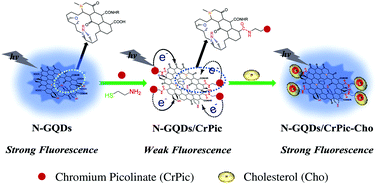当前位置:
X-MOL 学术
›
J. Mater. Chem. B
›
论文详情
Our official English website, www.x-mol.net, welcomes your feedback! (Note: you will need to create a separate account there.)
Fluorescence detection of cholesterol using a nitrogen-doped graphene quantum dot/chromium picolinate complex-based sensor
Journal of Materials Chemistry B ( IF 7 ) Pub Date : 2017-10-30 00:00:00 , DOI: 10.1039/c7tb02037f Long Sun 1, 2, 3 , Shanshan Li 1, 2, 3 , Wei Ding 1, 2, 3 , Yuewei Yao 1, 2, 3 , Xueyun Yang 1, 2, 3 , Cheng Yao 1, 2, 3
Journal of Materials Chemistry B ( IF 7 ) Pub Date : 2017-10-30 00:00:00 , DOI: 10.1039/c7tb02037f Long Sun 1, 2, 3 , Shanshan Li 1, 2, 3 , Wei Ding 1, 2, 3 , Yuewei Yao 1, 2, 3 , Xueyun Yang 1, 2, 3 , Cheng Yao 1, 2, 3
Affiliation

|
Nitrogen-doped graphene quantum dots (N-GQDs), with superior biocompatibility, strong resistance to photobleaching and convenient surface grafting, have sparked a surge of related-bio applications. In this study, combined with chromium picolinate (CrPic), N-GQDs synthesized by a facile hydrothermal approach are used to construct an environmentally-friendly sensor for the detection of cholesterol by exploiting the fluorescence enhancement of N-GQDs/CrPic. Herein, CrPic is grafted on N-GQDs via the linker of cysteamine (Cys), and the fluorescence of the N-GQDs is quenched by photoinduced electron transfer (PET), wherein CrPic functions as an electron donating group and the N-GQDs serves as an electron accepting group. Besides, cholesterol is stimulated to form a favourable complex with N-GQDs/CrPic because CrPic also acts as a potential receptor for cholesterol by strong affinity and π–π interaction, and the fluorescence of N-GQDs/CrPic is enhanced indicating that cholesterol could impede electron transfer from CrPic to the N-GQDs. This N-GQDs/CrPic-based sensor has been successfully applied to selectively determine the concentration of cholesterol with a linear range of 0–520 μM and a limit of detection (LOD) of 0.4 μM. Meanwhile, this present sensing strategy in human serum has acceptable practicability, reproducibility and precision.
中文翻译:

使用基于氮的石墨烯量子点/吡啶甲酸铬络合物传感器对胆固醇进行荧光检测
氮掺杂石墨烯量子点(N-GQDs)具有卓越的生物相容性,强的抗光漂白性和便利的表面接枝,已引发了相关生物应用的激增。在这项研究中,结合吡啶甲酸铬(CrPic),通过简便的水热法合成的N-GQDs被用于构建环保的传感器,通过利用N-GQDs / CrPic的荧光增强来检测胆固醇。此处,CrPic通过以下方式嫁接到N-GQD上通过半胱胺(Cys)的连接基(Cys),N-GQDs的荧光通过光致电子转移(PET)猝灭,其中CrPic用作电子给体基团,N-GQDs用作电子接受基团。此外,胆固醇被刺激与N-GQDs / CrPic形成良好的复合物,因为CrPic还通过强亲和力和π-π相互作用充当胆固醇的潜在受体,并且N-GQDs / CrPic的荧光增强,表明胆固醇可以阻止电子从CrPic转移到N-GQD。这种基于N-GQDs / CrPic的传感器已成功应用于选择性测定胆固醇的浓度,其线性范围为0–520μM,检出限(LOD)为0.4μM。同时,目前在人血清中的传感策略具有可接受的实用性,可再现性和精确性。
更新日期:2017-11-08
中文翻译:

使用基于氮的石墨烯量子点/吡啶甲酸铬络合物传感器对胆固醇进行荧光检测
氮掺杂石墨烯量子点(N-GQDs)具有卓越的生物相容性,强的抗光漂白性和便利的表面接枝,已引发了相关生物应用的激增。在这项研究中,结合吡啶甲酸铬(CrPic),通过简便的水热法合成的N-GQDs被用于构建环保的传感器,通过利用N-GQDs / CrPic的荧光增强来检测胆固醇。此处,CrPic通过以下方式嫁接到N-GQD上通过半胱胺(Cys)的连接基(Cys),N-GQDs的荧光通过光致电子转移(PET)猝灭,其中CrPic用作电子给体基团,N-GQDs用作电子接受基团。此外,胆固醇被刺激与N-GQDs / CrPic形成良好的复合物,因为CrPic还通过强亲和力和π-π相互作用充当胆固醇的潜在受体,并且N-GQDs / CrPic的荧光增强,表明胆固醇可以阻止电子从CrPic转移到N-GQD。这种基于N-GQDs / CrPic的传感器已成功应用于选择性测定胆固醇的浓度,其线性范围为0–520μM,检出限(LOD)为0.4μM。同时,目前在人血清中的传感策略具有可接受的实用性,可再现性和精确性。



























 京公网安备 11010802027423号
京公网安备 11010802027423号